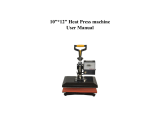
7Operating manual ecoTEC 0020052777_00
3.6 Energy saving tips
Installing a weather compensator
Weather-compensators regulate the heating feed tem-
perature with reference to the outside temperature. No
more heat is generated than is currently required. The
designated heating flow temperature for the corre-
sponding outside temperature must be set on the
weather compensator. This setting must not be greater
than required by the heating installation design. The
correct setting is normally undertaken by the heating
engineer. The required heating and set-back phases
(e.g. at night) are automatically switched on/off using
integrated timer programs. Weather compensators com-
bined with thermostat valves are the most economical
form of heating regulation.
Reducing the heating system
Reducing the room temperature at night and in your ab-
sence. This is most easily and reliably achieved using
controllers with timer programs that can be selected ac-
cording to individual requirements. At such times, set
the room temperature approx. 5 °C lower than during
full heating times. Reduction of more than 5 °C brings
no additional energy saving, because then increased
heating capacities would be needed for the next full
heating period. Only for longer absences, e.g. holidays,
is it worthwhile to further lower the temperatures. How-
ever, in winter, make sure that there is adequate frost
protection.
Room temperature
Set the room temperature only as high as would be
enough for your comfort level. An extra degree would
mean increased energy consumption of about 6%. Ad-
just the room temperature according to the use of the
specific room. For example, normally, bedrooms or sel-
dom used rooms are heated to 20 °C.
Setting the operating mode
In warmer seasons, when the apartment needs no heat-
ing, turn the heating to summer mode. The heating
mode is then shut off, however, the device or the plant
remains ready for operation for water heating.
Uniform heating
Often, in an apartment with central heating, only one
room is heated. Adjacent rooms are also heated without
regulation by the enclosing surfaces of the room, i.e.
walls, doors, windows, roofs, floors, which means that
an unwanted loss of thermal energy occurs. In these
kind of operating conditions the power of the radiator in
this heated room is obviously insufficient. Consequently,
the room cannot be heated adequately and an uncom-
fortable feeling of coolness prevails (the same effect is
produced when doors between heated and unheated or
partially heated rooms remain open). This is incorrect
saving: The heating is in operation and still the room
temperature is not comfortably warm.
Greater heating comfort and a more practical operating
mode is achieved when all rooms in an apartment are
heated uniformly and in accordance to their usage. The
building structure can also suffer if components of the
building are unheated or only inadequately heated.
Thermostat valves and room thermostat
Nowadays, all radiators should be fitted with thermo-
static valves as a matter of course. They maintain the
set room temperature precisely. You can adjust the
room temperature to suit your individual requirements
and ensure effective operation of your heating installa-
tion using thermostatic valves in combination with a
room thermostat (or weather compensator). All the ra-
diator valves should be fully opened in the room where
the room thermostat is located, as otherwise the two
control systems will influence one another and the regu-
lation quality will be adversely affected. Incidentally, the
following user behaviour is frequently observed: As
soon as the room becomes too hot the user turns the
thermostatic valve off (or specifies a lower temperature
at the room thermostat). If after a period of time the
user feels cold and opens the thermostatic valve again.
This procedure is not only inconvenient, it is also com-
pletely unnecessary as a correctly functioning thermo-
static valve does this automatically: If the room temper-
ature rises above the value set on the sensor head, the
thermostat valve shuts off automatically, when the tem-
perature drops below the defined value, it opens again.
Do not cover regulators
Do not cover your regulators with furniture, drapes or
similar objects. The room air must circulate unhindered.
Covered thermostat valves can be equipped with re-
mote sensors and thus still work.
Appropriate hot water temperature
The hot water should only be heated to the required
temperature. Any further heating results in unnecessary
power consumption and hot water temperatures of
more than 60 °C also lead to increased lime scale re-
duction.
Energy-conscious use of water
Energy-conscious use of water can also reduce costs
considerably. e. g. showering instead of bathing: where-
as about 150 litres of water are required for a bath, a
modern shower equipped with water saving fittings uses
around a third of this quantity. By the way: a dripping
water tap wastes up to 2000 litres of water and a leak-
ing toilet flush up to 4000 litres of water each year. A
new seal costs very little by comparison.
Run circulation pumps only if needed
Circulation pumps facilitate the continuous circulation
of hot water through the piping system which means
that hot water is immediately available, also at more
distant draw-off points.
Instructions on operation 3






















